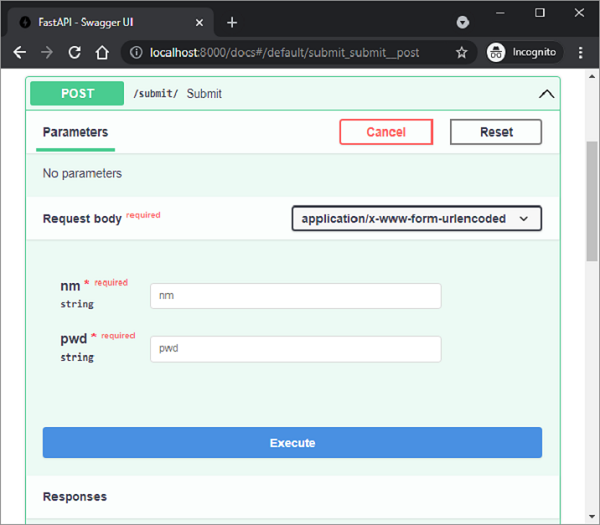
- FastAPI - Home
- FastAPI - Introduction
- FastAPI - Hello World
- FastAPI - OpenAPI
- FastAPI - Uvicorn
- FastAPI - Type Hints
- FastAPI - IDE Support
- FastAPI - Rest Architecture
- FastAPI - Path Parameters
- FastAPI - Query Parameters
- FastAPI - Parameter Validation
- FastAPI - Pydantic
- FastAPI - Request Body
- FastAPI - Templates
- FastAPI - Static Files
- FastAPI - HTML Form Templates
- FastAPI - Accessing Form Data
- FastAPI - Uploading Files
- FastAPI - Cookie Parameters
- FastAPI - Header Parameters
- FastAPI - Response Model
- FastAPI - Nested Models
- FastAPI - Dependencies
- FastAPI - CORS
- FastAPI - Crud Operations
- FastAPI - SQL Databases
- FastAPI - Using MongoDB
- FastAPI - Using GraphQL
- FastAPI - Websockets
- FastAPI - FastAPI Event Handlers
- FastAPI - Mounting A Sub-App
- FastAPI - Middleware
- FastAPI - Mounting Flast App
- FastAPI - Deployment
- FastAPI Useful Resources
- FastAPI - Quick Guide
- FastAPI - Useful Resources
- FastAPI - Discussion
FastAPI - Accessing Form Data
Now we shall see how the HTML form data can be accessed in a FastAPI operation function. In the above example, the /login route renders a login form. The data entered by the user is submitted to /submit URL with POST as the request method. Now we have to provide a view function to process the data submitted by the user.
FastAPI has a Form class to process the data received as a request by submitting an HTML form. However, you need to install the python-multipart module. It is a streaming multipart form parser for Python.
pip3 install python-multipart
Add Form class to the imported resources from FastAPI
from fastapi import Form
Let us define a submit() function to be decorated by @app.post(). In order to receive the form data, declare two parameters of Form type, having the same name as the form attributes.
@app.post("/submit/")
async def submit(nm: str = Form(...), pwd: str = Form(...)):
return {"username": nm}
Press submit after filling the text fields. The browser is redirected to /submit URL and the JSON response is rendered. Check the Swagger API docs of the /submit route. It correctly identifies nm and pwd as the request body parameters and the forms "media type" as application/x-www-form-urlencoded.

It is even possible to populate and return Pydantic model with HTML form data. In the following code, we declare User class as a Pydantic model and send its object as the server response.
from pydantic import BaseModel
class User(BaseModel):
username:str
password:str
@app.post("/submit/", response_model=User)
async def submit(nm: str = Form(...), pwd: str = Form(...)):
return User(username=nm, password=pwd)